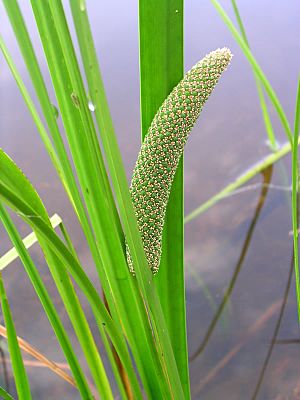American sweet flag facts for kids
Quick facts for kids American sweet flag |
|
|---|---|
 |
|
| Scientific classification | |
| Genus: |
Acorus
|
| Species: |
americanus
|
The American sweet flag (Acorus americanus) is a cool plant that grows in wet places like swamps and marshes. You can find it in the northern United States and Canada. This plant lives for many years.
It has bright green leaves shaped like blades. These leaves grow right from the plant's underground stems, called rhizomes. The leaves also have raised lines, like veins, and feel a bit thick in the middle.
The leaves smell spicy, a bit like citrus fruit. People have even used them to add flavor to beer. The American sweet flag also has small flowers. These flowers grow on a thick, fleshy stalk called a spadix. After the flowers are pollinated, they make berries with a jelly-like inside.
In Pennsylvania, this plant is considered an endangered species. This means it needs special protection to help it survive.
What's in a Name?
The name "Acorus" comes from an old Greek word, 'acoron'. A famous Greek doctor named Dioscorides used this name. It came from 'coreon', which means 'pupil' of the eye. This is because people once used the plant in herbal medicine to help with eye swelling.
The second part of the name, "americanus", simply tells us where the plant is from. It means it is an American species. This helps us tell it apart from a very similar plant, Acorus calamus, which grows in Europe and Asia.
How It's Classified
The American sweet flag, Acorus americanus, used to be thought of as just a type of Acorus calamus. But scientists now know it's its own species.
The main difference is how many sets of chromosomes they have. Acorus americanus has two sets of chromosomes. This makes it a "diploid" plant. Because it's diploid, it can produce seeds and spread easily. Most A. calamus plants in Europe and Asia have three sets of chromosomes. This makes them "triploid" and usually means they cannot make seeds. They only spread by growing new plants from their roots.
How People Used It
The American sweet flag was very important to Native Americans. They used it for many things. Early European settlers also found ways to use this plant.

